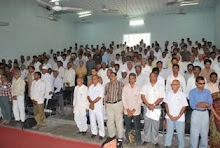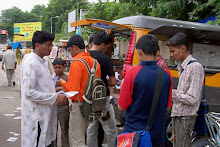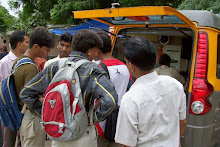Times of India: New Delhi:
Monday, March 17, 2014.
Death by iron
rods or construction material improperly loaded on a truck may appear caused by
a freak accident. But it's not. Activist Piyush Tewari estimates that about 10%
of the 1.4 lakh annual road deaths in India are due to protruding rods and
stationary trucks. The one positive is that these accidents are easily
preventable.
Which is why
Tewari, 33, has spent the last two years collecting data across states and
campaigning for a ban on vehicles carrying rods, pipes or any protruding
material beyond the body frame. Last week, in response to a public interest
litigation (PIL) he filed in Supreme Court in 2013, the road transport ministry
deleted the provision in the Central Motor Vehicle Rules (CMVR) that allowed
protrusions up to one metre.
"The
notification came five years after we started campaigning," says Tewari, a
former private equity fund manager and founder of SaveLIFE Foundation (SLF), an
NGO focused on emergency medical aid for road accident victims.
For five
years, Tewari had been making a list of horrific accidents of people dying
because of iron rods ramming through their bodies at high speeds, by vehicles,
motorized and otherwise, crashing into trucks and heavy vehicles improperly
loaded. The frequency of these accidents is what prompted Tewari to find out
how many people actually die like this in India. "I wanted to pick a topic
which was very visible to me. Starting in 2009, we used Right to Information
(RTI) to ask states for data about protruding rods and stationary trucks,"
he says.
Statistically,
since 2006, India has suffered the highest number of road accident deaths in
the world an average of about 15 per hour. But RTI data from the states varies
and only a few states responded to requests (Punjab and Karnataka are still
pending). For instance, between 2009 and 2011, improperly loaded trucks caused
1,179 deaths in Rajasthan, 139 in Delhi, 856 in Chattisgarh and 134 for
Himachal Pradesh. Tewari attributes the widely disparate numbers to erroneous
recording of cause of death.
"Because
our data is so weak, we don't even know the total number of victims, which is
way higher. But this is such a preventable situation," says Dr Manjul
Joshipura, former director of WHO, trauma services.
Since Tewari
and SLF started working on this issue, several families that had loved ones
killed in these gory accidents, visited Tewari in solidarity. "We have had
such emotional scenes in the office. Thousands of people approached us. Our
campaign on Facebook has half a million people, many of whom responded with
stories of their children, relatives, friends, colleagues," says Tewari,
who along with support, has also received threat calls that said 'Great work
but you know you can also meet with an accident'.
He recounts
the story of a family that lost its only child, a 29-year-old journalist, who
was returning to his home in Gurgaon and drove into a barely visible truck
loaded with iron rods.
Hundreds of
thousands of such earning members have died in road accidents. Tewari says
several of accident victims are from the lower-earning strata, which adds to
the economic burden. He says, "Last decade 1.1 million died in road
accidents and 5.3 million have been permanently disabled. About 50% of these
have been bread winners. While the government keeps trying to remove poverty,
this adds to the number every year. Majority of these are on the road to earn a
living. Any other cause, any disease that was causing a million deaths would
get political attention."
The recent
ruling was only a first hurdle crossed. SLF's PIL is still pending on who
should be punished for these trucks the owners and not the drivers. Tewari is
also fighting for a proper barricading system for stationary trucks on sides of
roads which will allow motorists to spot them from a safe distance. "We
have to ensure that the law is implemented across the country now," he
says.














































































